The Artist In All Of Us
By John M. Hotchner
Many of us would not use that label to describe ourselves. But consider the American Heritage Dictionary of the English Language (1976) second definition of “art:”  The conscious production or arrangement of sounds, colors, forms, movements, or other elements in a manner that affects the sense of beauty; specifically, the production of the beautiful in a graphic or plastic medium.
The conscious production or arrangement of sounds, colors, forms, movements, or other elements in a manner that affects the sense of beauty; specifically, the production of the beautiful in a graphic or plastic medium.
Granted, putting stamps in an album may fall short of creativity, but it is adding graphic material and color to a page that results in a pleasing display – not unlike painting by numbers. And if you make your own albums or pages for new acquisitions, there is no doubt that you are an artist; one who creates works of art. In exercising this skill, you are balancing form, text, color, and even design content with the goal of conveying meaning through a pleasing sense of beauty.
I have long said of myself that I can barely draw a straight line, and circles are quite beyond me, but I can make a pleasing exhibit page, and accumulate a group of them into 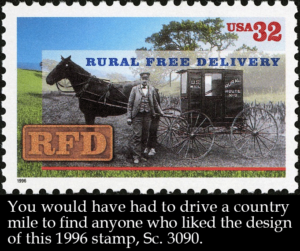 an award-winning exhibit or one that is non-competitive but still attractive to viewers. I’ll never be a Picasso, but this is my art.
an award-winning exhibit or one that is non-competitive but still attractive to viewers. I’ll never be a Picasso, but this is my art.
Now, for the definition of “artist:” (2) Any person who performs his work as if it were an art. We who study our stamps – both those who focus on the physical elements of the stamp and those who focus on the design content – invest them with a meaning beyond the work they do to move mail. In fact, a great many of them never move mail because we like to be able to appreciate the beauty or content of their designs without the obstruction of cancellation marks.
It is not unusua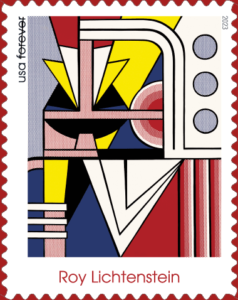 l for stamp collectors to reject certain stamps as being artistically inferior, in their view. And woe be to a postal service that ignores the sense of art of its buying public. Postal Services need to pay attention to this factor because it affects their bottom line. If collectors will not buy the product, or flock in droves to add a country’s stamps to their collections, the issuing authorities get valuable guidance about what the public likes.
l for stamp collectors to reject certain stamps as being artistically inferior, in their view. And woe be to a postal service that ignores the sense of art of its buying public. Postal Services need to pay attention to this factor because it affects their bottom line. If collectors will not buy the product, or flock in droves to add a country’s stamps to their collections, the issuing authorities get valuable guidance about what the public likes.
And, thus, a third definition and concept, this one for “artistic:” (2) Appreciative of or sensitive to art or beauty. Clearly, we all have opinions and few of us are shy about expounding on them. We may like impressionism, or be left cold by it. We may be attracted, or not, to cartoon art, poster art, primitive art, bowls of fruit, watercolors, or whatever else is offered. But we are often very much in touch with those feelings and disposed to act on them.
The first thing that a postal service announces about a new issue is the subject. Sometimes a design will accompany that announcement. Often th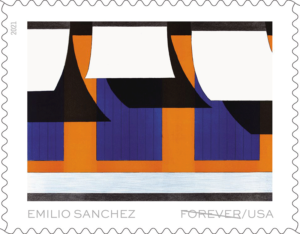 e design follows at a respectful distance. But for every collector who does not like a subject, I’ll bet there are ten who feel more passion about the art when it is revealed. Great art can redeem a bad subject, but poor art can kill a good one.
e design follows at a respectful distance. But for every collector who does not like a subject, I’ll bet there are ten who feel more passion about the art when it is revealed. Great art can redeem a bad subject, but poor art can kill a good one.
Of course, the definition of great and poor is in the eye of the beholder, and may be informed by training or education. Or it may simply be, in the words of the mythical Joe Sixpack, “I know what I like – and what I don’t.” In other words, we may not all be designers, but we are, every last one of us, a critic!
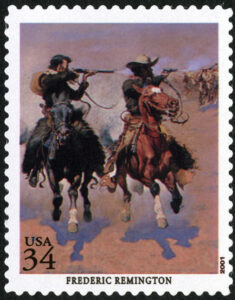 And here is where we miss an opportunity to market our hobby to the wider world. We are not unique as critics. Everyone, even those struggling to put food on the table, has an opinion. Put a picture by Remington in front of a man or woman in the street, and the great majority will have an opinion. A majority or those will probably say that whoever the artist is, if the painting cost $25, they would buy it.
And here is where we miss an opportunity to market our hobby to the wider world. We are not unique as critics. Everyone, even those struggling to put food on the table, has an opinion. Put a picture by Remington in front of a man or woman in the street, and the great majority will have an opinion. A majority or those will probably say that whoever the artist is, if the painting cost $25, they would buy it.
The difference between the painting and the stamp showing it is that the stamp is smaller, and a copy, but it is eminently affordable; not so in the original unless you have a few spare millions lying about.
All stamps are miniature art works. In fact. it is one of the aspects of art that even stamp collectors likely don’t appreciate: the difficulty of presenting on a palette that is at most an inch and a half square (and often less) a comprehensible multicolor piece of art that lends 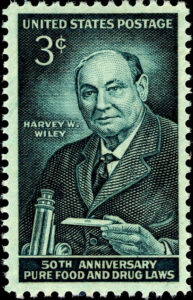 itself to printing, conveys a message, and is pleasing to the eye.
itself to printing, conveys a message, and is pleasing to the eye.
One of the most popular series of articles ever run in the philatelic press was Kent Stiles’ series in the old Scott Monthly Journal (later continued by Belmont Faries) showing the several different finalists from which a stamp design was eventually chosen and issued. An example, the 3¢ Dr. Harvey Wiley (Pure Food & Drug Laws, Sc. 1080) stamp, from the September, 1956, issue is shown on the right.
If further proof were needed, some of the most fascinating displays put up by the National Postal Museum are the ones featuring final candidates for stamp issuances that were not selected (from The Postmaster General’s Collection, which has been entrusted to the NPM).
One need not be a collector to debate the merits of the contenders for a stamp design, and I bet a series in the popular press presenting this sort of question would interest a lot of people in philately, and if presented with a paragraph on what to do next to get started, 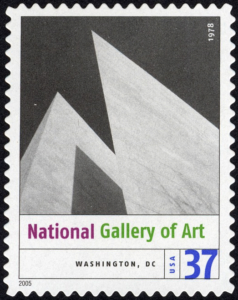 would bring a new cohort to the hobby.
would bring a new cohort to the hobby.
If we could gather into the fold 5% of the people who consider themselves to be art appreciation fanatics – who go to museums, who buy art for their homes, who purchase coffee-table books featuring the masterworks, we could reverse the trend toward fewer and fewer collectors!
How? Lectures at museums, articles for art magazines, stamp auctioneers targeting art buyers, a line of enlargements of especially attractive stamps to be sold through museum stores, art supply shops, etc. I am certain there are many other ideas that could be proposed. If you have one, send or post a comment.
Should you wish to comment on this column, or have questions or ideas you would like to have explored in a future column, please write to John Hotchner, VSC Contributor, P.O. Box 1125, Falls Church, VA 22041-0125, or email, putting “VSC” in the subject line.
Or comment right here.




I had not given much attention to the topics Hotchner addressed in his essay but often times “art is in the eye of the beholder.” Who would look at the portrait deVinci created and say, “that is a beautiful lady” (Mona Lisa) while, by an art collector who would offer his assessment “that is truly a work of art.” Still, Hotchner offers great insight into stamp designs from multiple perspectives and I appreciate his focus and reviews. Stamps: works of art or creative functions for postal useage? Answer lies with the reader/viewer/collector. Which am I?